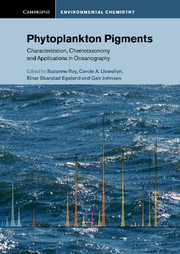Book contents
- Frontmatter
- Contents
- Contributors
- Preface
- Acknowledgements
- Abbreviations and symbols
- Part I Chlorophylls and carotenoids
- Part II Methodology guidance
- 4 New HPLC separation techniques
- 5 The importance of a quality assurance plan for method validation and minimizing uncertainties in the HPLC analysis of phytoplankton pigments
- 6 Quantitative interpretation of chemotaxonomic pigment data
- 7 Liquid chromatography-mass spectrometry for pigment analysis
- 8 Multivariate analysis of extracted pigments using spectrophotometric and spectrofluorometric methods
- Part III Water-soluble ‘pigments’
- Part IV Selected pigment applications in oceanography
- Part V Future perspectives
- Part VI Aids for practical laboratory work
- Part VII Data sheets aiding identification of phytoplankton carotenoids and chlorophylls
- Index
- Plate Section
- References
5 - The importance of a quality assurance plan for method validation and minimizing uncertainties in the HPLC analysis of phytoplankton pigments
Published online by Cambridge University Press: 05 March 2012
- Frontmatter
- Contents
- Contributors
- Preface
- Acknowledgements
- Abbreviations and symbols
- Part I Chlorophylls and carotenoids
- Part II Methodology guidance
- 4 New HPLC separation techniques
- 5 The importance of a quality assurance plan for method validation and minimizing uncertainties in the HPLC analysis of phytoplankton pigments
- 6 Quantitative interpretation of chemotaxonomic pigment data
- 7 Liquid chromatography-mass spectrometry for pigment analysis
- 8 Multivariate analysis of extracted pigments using spectrophotometric and spectrofluorometric methods
- Part III Water-soluble ‘pigments’
- Part IV Selected pigment applications in oceanography
- Part V Future perspectives
- Part VI Aids for practical laboratory work
- Part VII Data sheets aiding identification of phytoplankton carotenoids and chlorophylls
- Index
- Plate Section
- References
Summary
Introduction
A quality assurance plan (QAP) describes a process to ensure an analytical method fulfils the agreed upon accuracy objectives at all points during the analysis of samples. A QAP includes such things as standardized procedures, method validation, quality control (QC) measurements, and quality assessment (QA); the latter quantitatively describes how results of QC measurements are used to determine whether a method is performing within expectations. By analogy, a QAP describes what can be considered, in a more general sense, a ‘holistic’ approach to sample analysis, whereby the ‘whole is considered to be a result of the interdependence of all parts’. Here, the ‘whole’ represents the overall combined uncertainty of a final data product, and ‘the interdependence of all parts’ represents the uncertainties contributed by the many individual procedures required to produce that final data product.
An in depth discussion of uncertainty analysis in the chemical laboratory, given in EURACHEM (2000), is beyond the scope of this chapter, but the importance of a so-called holistic approach to sample analysis, whether this includes a formalized QAP or not, is necessary to provide knowledge of the uncertainties associated with measured values and, thus, facilitate confidence in the data products. Such knowledge is important, because pigment data are often compiled in increasingly large databases, and end users of the data are remote (in space and time) from the data providers. Knowing the accuracy of the data facilitates their wider utility, for both current and unanticipated future applications. This chapter describes components of a QAP in the context of knowledge gained during intercomparisons sponsored by the National Aeronautics and Space Administration (NASA). A primary objective of these activities was to determine if the myriad providers of HPLC analyses to NASA researchers were satisfying the accuracy requirements for field observations.
- Type
- Chapter
- Information
- Phytoplankton PigmentsCharacterization, Chemotaxonomy and Applications in Oceanography, pp. 195 - 256Publisher: Cambridge University PressPrint publication year: 2011
References
- 21
- Cited by

